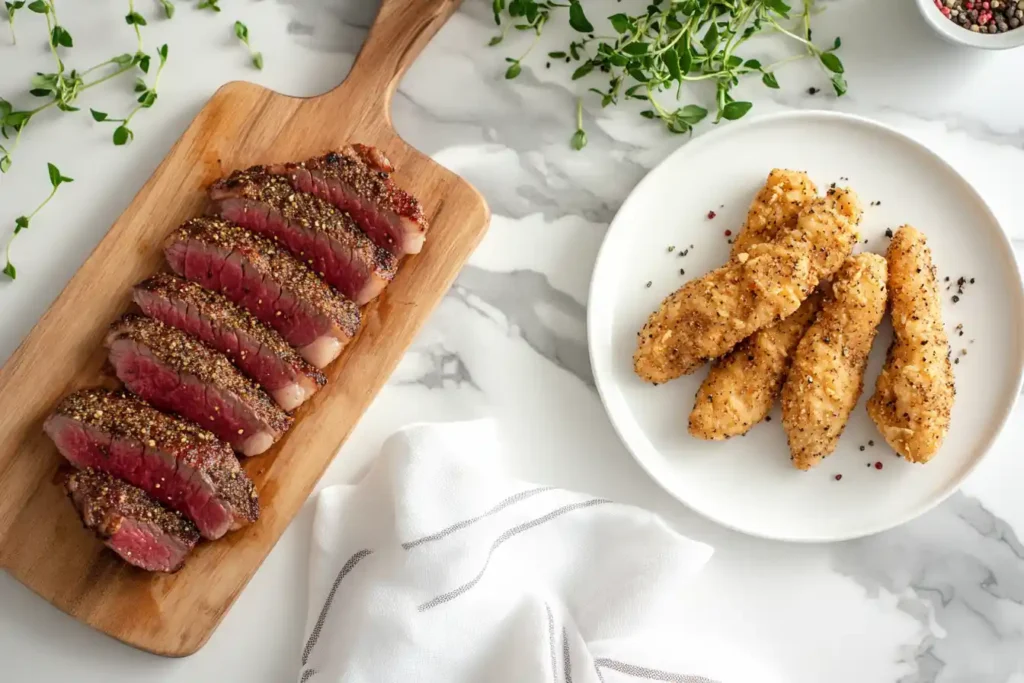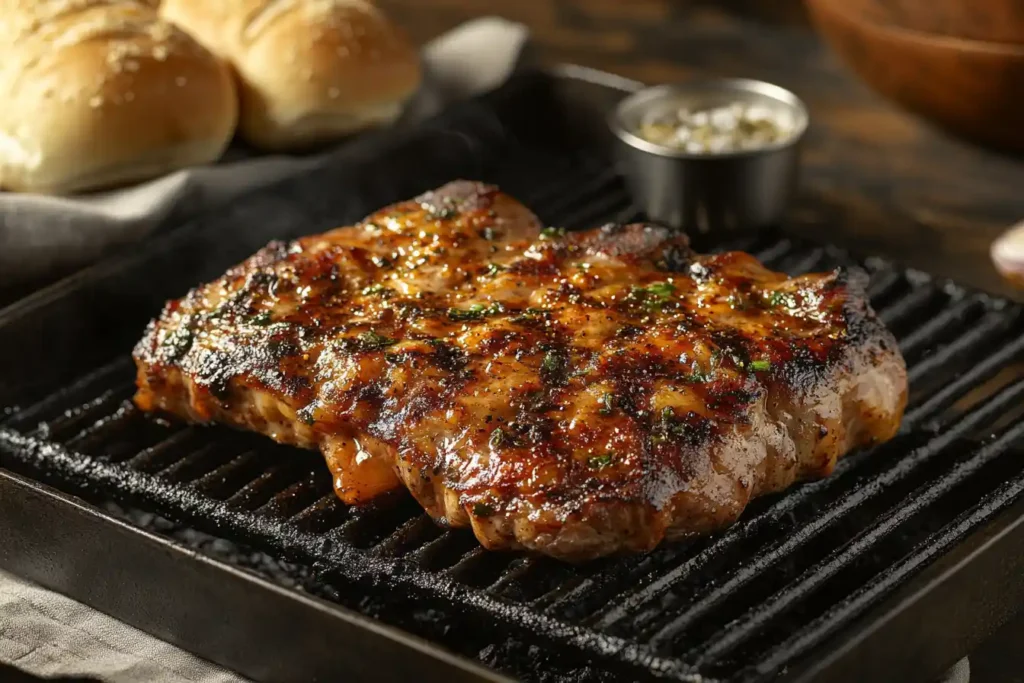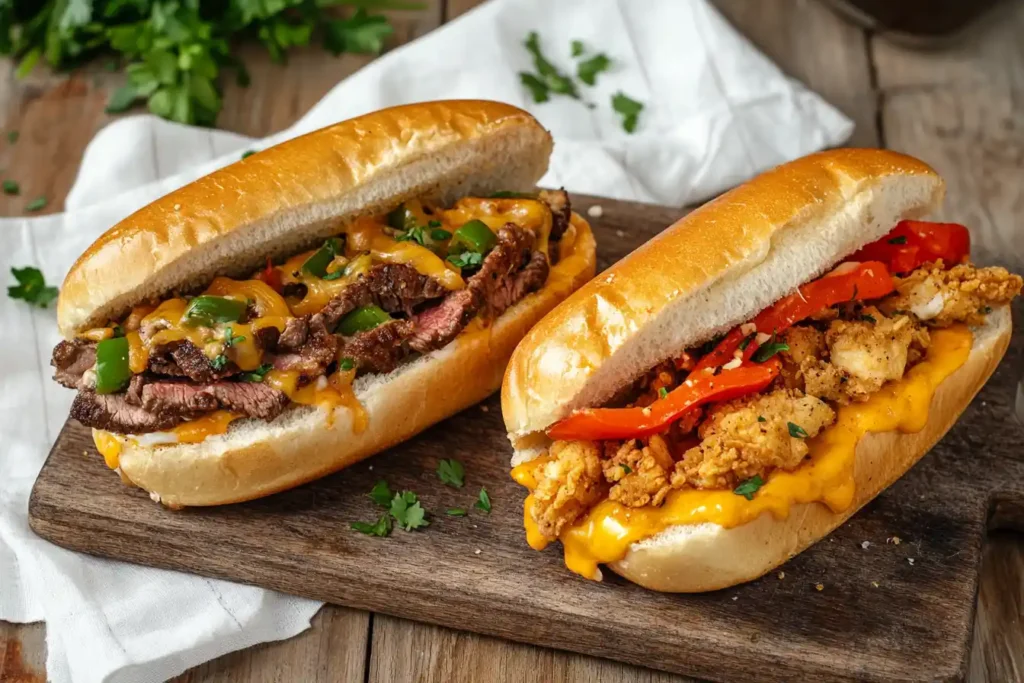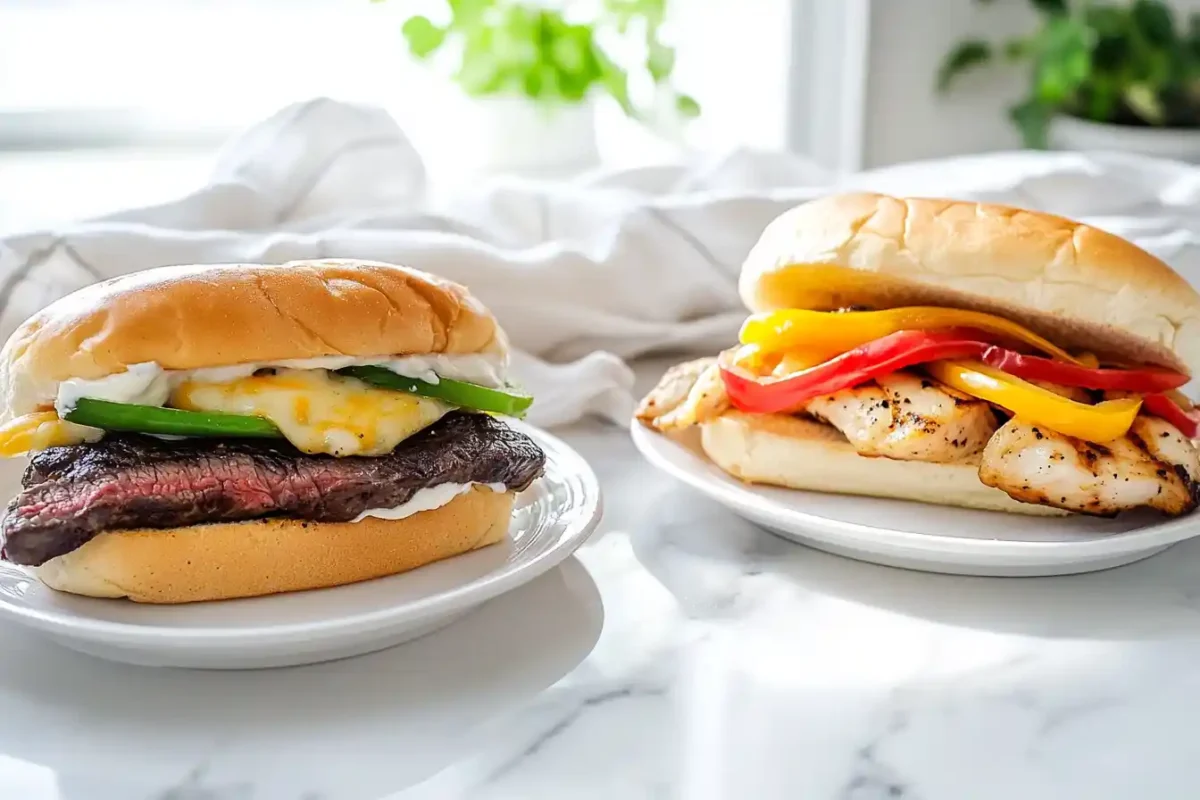Introduction
When it comes to the world of sandwiches, few debates stir more excitement than the one Difference between Chicken Philly and Philly Cheesesteak lovers. Both sandwiches are hearty, packed with flavor, and iconic in their own right but they aren’t identical twins. Instead, they each bring unique ingredients, preparation techniques, and flavors to the table.
The Philly cheesesteak is known for its rich, beefy goodness topped with melted cheese, while the Chicken Philly takes a lighter, juicier approach with grilled chicken and often fresh veggies. This article unpacks the history, components, taste profiles, and preparation methods of these two fan-favorite sandwiches to see what truly sets them apart. So, whether you’re a die-hard cheesesteak enthusiast or someone looking to try a lighter variation, you’re in the right place!
Historical Background
Origins of the Philly Cheesesteak
The Philly cheesesteak story starts in the heart of Philadelphia during the 1930s. Pat Olivieri, a local hot dog vendor, decided to shake things up by cooking some thinly sliced beef on his grill. The scent wafted through the air and caught the attention of a cab driver passing by, who asked for a taste. And just like that—bam!—a legend was born.
Pat’s simple experiment turned into a sensation, and soon enough, people were lining up for this new beefy creation. In no time, Pat opened “Pat’s King of Steaks,” which still stands as one of the most iconic spots for a cheesesteak today. Over time, the cheesesteak evolved, with cheese (often Cheez Whiz) added to create the creamy, savory sandwich we know and love.
Emergence of the Chicken Philly
The Chicken Philly came along much later—sometime in the 1990s—when people began craving healthier alternatives to beef without losing the indulgent, cheesy appeal of the classic sandwich. The concept was simple: replace the ribeye steak with seasoned, grilled chicken breast or thigh meat.
Restaurants quickly hopped on the trend, adding fresh vegetables like sautéed bell peppers and onions to enhance the overall texture and taste. The Chicken Philly became a hit, especially among those looking for a lower-fat, protein-packed version of their favorite sandwich. It carved out its place in the sandwich world, showing that even small tweaks to a classic recipe could create something entirely new yet equally delicious.
Core Ingredients

When comparing the Chicken Philly and Philly cheesesteak, their differences begin with the key components: the meat and the cheese. These ingredients not only define the flavor profile but also determine the richness and overall vibe of each sandwich. Let’s break down how each ingredient plays its part in making these sandwiches so distinct yet equally irresistible.
Meat Selection
Beef in Philly Cheesesteak
A traditional Philly cheesesteak relies on thinly sliced ribeye steak, prized for its marbling, which melts down during cooking to create that juicy, savory richness. The ribeye’s fat content ensures that every bite is tender and full of flavor. The steak is cooked quickly on a flat-top grill until it develops a slight crust, sealing in the juices. For extra depth, onions are often grilled alongside the meat, releasing their natural sweetness and blending beautifully with the beef.
The beef’s quality and thinness are crucial; if it’s sliced too thick, the texture becomes chewy rather than melt-in-your-mouth tender. This simple yet precise process is what elevates a Philly cheesesteak from an ordinary beef sandwich to an iconic dish.
Chicken in Chicken Philly
The Chicken Philly, in contrast, substitutes ribeye with boneless, skinless chicken breast or thighs. The choice between breast and thigh meat usually depends on personal preference—breast meat is leaner, while thighs offer a slightly richer, juicier taste. The chicken is typically cut into thin strips or small chunks to mimic the shredded appearance of steak.
Seasoning plays a big role here. The chicken is often marinated or coated with simple seasonings like salt, pepper, garlic powder, or paprika. As the chicken sizzles on the flat-top grill, it absorbs flavors from the oil, onions, and bell peppers cooked alongside it. The result? A tender, flavorful filling that holds its own against the boldness of traditional steak.
Cheese Variations
Traditional Cheeses Used
One of the key elements that define a Philly cheesesteak is the cheese—and you’ve got options! The three most commonly used cheeses are Cheez Whiz, provolone, and American cheese. Cheez Whiz, in particular, is a Philly institution. Its velvety, tangy consistency coats the steak perfectly, giving the sandwich its signature creaminess.
Provolone offers a milder, slightly nutty flavor, while American cheese melts smoothly and adds a subtle richness. The choice of cheese can completely change the sandwich’s character, but no matter which you pick, it’s all about getting that gooey, melty goodness.
Modern Cheese Options
When it comes to Chicken Philly sandwiches, provolone is often the top choice, as its mild, slightly salty profile pairs perfectly with grilled chicken. However, some people like to experiment with other cheeses, such as mozzarella for a stretchy, milky texture or pepper jack for a bit of a spicy kick.
Cheese variety gives the Chicken Philly a more versatile edge, appealing to those who want to play with flavors. Whether you stick to tradition or mix things up, the cheese always plays a starring role in tying together the flavors of the sandwich.
Preparation Techniques

One of the biggest differences between a Philly cheesesteak and a Chicken Philly lies in how the ingredients are cooked. The preparation process not only affects the taste but also the texture and overall satisfaction of each bite. Though both sandwiches use the beloved flat-top grill technique, the way the meat and veggies are handled creates distinct outcomes.
Cooking Methods for Philly Cheesesteak
An authentic Philly cheesesteak starts with the flat-top grill sizzling hot. Thinly sliced ribeye steak hits the surface, cooking quickly as the fat renders down and infuses the meat with flavor. The goal is to get the beef slightly browned yet tender, with no dryness in sight. The steak is chopped or gently stirred with long spatulas to ensure every slice is evenly cooked.
Onions, a signature addition for many, are usually sautéed alongside the beef until golden and slightly caramelized. This step is crucial because the onions’ natural sweetness balances out the richness of the steak. If you’re going “wit” (Philly lingo for “with onions”), they’re folded into the beef at just the right time to meld together beautifully.
Once the steak is cooked and the onions softened, cheese is added directly on top of the beef. This technique allows the cheese to melt into the meat, creating a creamy layer that binds everything together. The final step is scooping the cheesy, meaty goodness into a long hoagie roll. The bread absorbs some of the juices while still holding its structure—because no one wants a soggy sandwich!
Cooking Methods for Chicken Philly
The Chicken Philly also uses a flat-top grill, but its preparation comes with a few flavorful twists. Since chicken lacks the natural marbling of ribeye, it’s often marinated beforehand to enhance its flavor and tenderness. Common seasonings include garlic powder, paprika, black pepper, and a touch of olive oil or lemon for moisture.
Once the grill is ready, the marinated chicken strips are added, sizzling away until they develop a slight sear. Unlike beef, chicken pieces need to be cooked until fully done but still juicy. This requires precise timing to avoid dryness.
Onions and bell peppers—staples in many Chicken Philly recipes—are cooked alongside the chicken, adding layers of sweetness and crunch. The colorful bell peppers not only enhance the visual appeal but also bring a fresh, slightly smoky note to the sandwich.
Just like the cheesesteak, cheese is layered on top of the chicken mixture at the end, ensuring it melts perfectly. The final assembly involves scooping the cheesy chicken mix into a roll, ready to be served hot and packed with flavor. The result is a hearty, satisfying sandwich with a slightly lighter and brighter taste than its beef counterpart.
Flavor Profiles

The flavor and texture of a sandwich can make or break the eating experience. Both the Philly cheesesteak and Chicken Philly have distinct characteristics that appeal to different palates. While the cheesesteak leans toward rich, indulgent flavors, the Chicken Philly presents a slightly lighter and fresher profile without compromising on heartiness.
Taste and Texture of Philly Cheesesteak
Biting into a Philly cheesesteak is like stepping into comfort food heaven. The combination of tender, juicy beef, gooey cheese, and a soft but slightly chewy hoagie roll creates the perfect harmony of textures. The ribeye steak brings an umami-rich depth of flavor, especially when cooked with just the right amount of fat. The beef’s richness is complemented by the creamy, slightly salty cheese that oozes over the meat.
The onions—if included—add a subtle, caramelized sweetness that cuts through the heaviness of the steak and cheese, adding balance to each bite. Whether the sandwich is made with Cheez Whiz, provolone, or American cheese, the result is always satisfying and indulgent. The bread also plays an important role, soaking up some of the juices without falling apart, giving the sandwich its signature “just messy enough” appeal.
Taste and Texture of Chicken Philly
The Chicken Philly offers a lighter but equally flavorful experience. The grilled chicken delivers a leaner, juicier bite compared to beef, and when seasoned well, it can pack just as much flavor. The chicken’s mild profile allows the other ingredients—such as onions, bell peppers, and cheese—to shine, creating a more dynamic range of flavors.
The bell peppers, often sautéed alongside the onions, add a fresh, slightly sweet crunch that complements the savory chicken. The melted cheese—whether provolone, mozzarella, or even pepper jack—blends smoothly into the chicken, giving the sandwich a creamy richness that holds everything together. The overall taste is less heavy than the cheesesteak but still comforting and satisfying. The hoagie roll, as always, plays its part by providing a sturdy but soft base that holds all the ingredients in perfect harmony.
Nutritional Comparison
When it comes to nutrition, the Philly cheesesteak and Chicken Philly offer different profiles, making one more appealing depending on your dietary goals. Both are filling, protein-packed options, but their calorie and fat content can vary significantly based on preparation and ingredients.
Calorie Content
A classic Philly cheesesteak can range from 500 to 700 calories per serving, though this depends largely on the portion size, the type of cheese used, and whether additional toppings like extra cheese or sauces are added. Ribeye steak, the meat traditionally used for cheesesteaks, is higher in calories due to its fat content. While this fat is key to the steak’s tenderness and flavor, it also significantly boosts the overall calorie count. The type of cheese also matters—Cheez Whiz and American cheese tend to add more calories than provolone, as they are richer in fat.
Fat and Protein Analysis
Nutritional Comparison of Philly Cheesesteak vs Chicken Philly (Per 100g)
| Nutrient | Philly Cheesesteak | Chicken Philly |
|---|---|---|
| Calories | 270 kcal | 190 kcal |
| Protein | 18g | 22g |
| Total Fat | 16g | 8g |
| Saturated Fat | 6g | 2g |
| Carbohydrates | 12g | 10g |
| Fiber | 1g | 1g |
| Sodium | 550mg | 420mg |
The Chicken Philly generally has fewer calories and saturated fats compared to its beefy counterpart. Chicken breast, commonly used in Chicken Philly sandwiches, is leaner than ribeye and provides a similar protein punch without the excess fat. A typical Chicken Philly may have 50 to 100 fewer calories per serving, especially if grilled chicken breast is used instead of thighs.
However, the way the chicken is cooked plays a big role in the sandwich’s final nutritional profile. Marinating the chicken in oil-heavy mixes or adding extra cheese can raise the calorie and fat content. Still, for those looking for a lighter, lower-fat option, the Chicken Philly remains a popular choice. Additionally, grilled onions and bell peppers enhance the nutrient profile by adding fiber and vitamins, giving the sandwich more nutritional balance without adding too many calories.
Frequently Asked Questions About Difference between Chicken Philly and Philly Cheesesteak
A Chicken Philly replaces ribeye steak with grilled chicken, often includes bell peppers, and can be seasoned differently, though the core elements of cheese, onions, and a hoagie roll remain the same.
Yes, in most cases. Chicken breast has lower fat content than ribeye steak, making the Chicken Philly a lower-calorie and lower-fat alternative.
Traditional options include Cheez Whiz, provolone, and American cheese. Each offers a unique flavor—Cheez Whiz is tangy and creamy, provolone is mild and nutty, and American cheese melts into a smooth, rich consistency.
Absolutely! You can substitute meat with portobello mushrooms or plant-based meat alternatives while keeping the same cheese, onions, and hoagie roll for a delicious vegetarian twist
Bell peppers add a fresh, sweet flavor that pairs well with the mild taste of chicken, making the sandwich more colorful and texturally diverse.
Conclusion Of Difference between Chicken Philly and Philly Cheesesteak
In the great debate between Philly cheesesteak and Chicken Philly, it ultimately comes down to personal preference. The Philly cheesesteak stands out for its bold, savory flavor and indulgent combination of tender ribeye, gooey cheese, and caramelized onions. On the other hand, the Chicken Philly offers a lighter, leaner take with juicy grilled chicken, fresh bell peppers, and a touch of seasoning that adds brightness to every bite.
Both sandwiches have carved out their place in the hearts of sandwich lovers across the nation, proving that whether you’re team beef or team chicken, there’s a delicious option for everyone. If you’re craving comfort food, either of these sandwiches will hit the spot—so why not try both and decide for yourself? After all, no sandwich debate is complete without firsthand experience!

